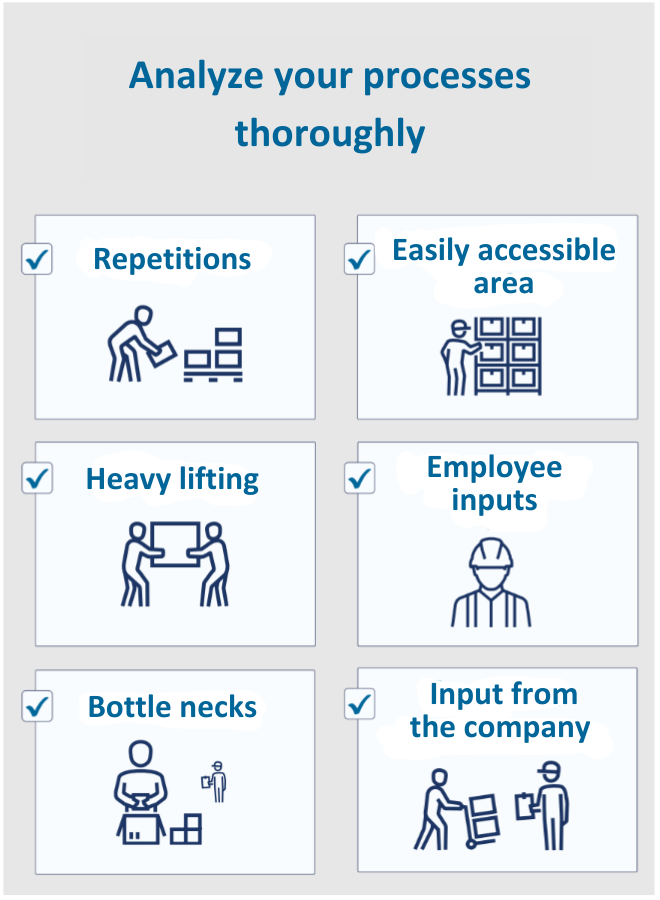Since every company is different, the best way to implement automation varies from one production to another. However, there are general guidelines to follow in order to identify areas where automation would be beneficial. The key is to focus on the most pressing issues, and to think in an agile and adaptable way.
Getting Started
Optimizing or changing production involves many tasks, so it may be a good idea to appoint someone in the company to drive the process forward and keep track of everything. This person will be responsible for gathering knowledge, keeping track of suppliers, and ensuring schedules and organization.
A steering group can also be appointed, consisting of employees with expertise in the project or area. This will clarify who can make the right choices during the process.
Once the responsibility is in place, it’s time to observe production as it is today. Make a plan and set aside time to go through all parts of your production in terms of inventory, packaging, and manufacturing processes, preferably with an extra set of eyes. Note the problems without thinking about the solutions. We’ll come to that later. We have gathered some tips on how to best identify the areas that could benefit from automation.
1. Find the Problems
All productions have areas where things are not running smoothly. Now is the time to bring all the issues to light.
Look for places where things are moving too slowly and bottlenecks occur, or where too many errors are generated. This may be because the offloading is not fast enough, or because the subsequent process is too complicated. It can also be a place that requires many changes, such as items that need to be packed differently or designs that need to be changed depending on the customer group or country.
You should also find all the places where simple manual processes are repeated many times. In other words, the places where an employee makes the same movements again and again.
There are often opportunities for optimization in palletizing or in places with heavy lifting that is repeated. In short, a good place to start is all the places where something needs to be done in the same way many times.

2. Start Small
It may be tempting to begin your transformation journey with a big and fancy new system. However, the best approach is to start small. Perhaps it’s just a matter of looking at automation in a single area. This could be because it’s an important area, but it could also be a practical isolated part with easy access.
There are many parts of the process where it may make sense to start. Maybe there are adding processes or assembly processes that can be updated and made more efficient. It could also be isolating the packaging process or assembly process and investing in technology specifically for these areas.
It makes sense to start with a small part and test how it works. For each organization, it’s unique how they will work with automation, and there will inevitably be learnings that will be taken from the first implementation, no matter how well things are researched beforehand!
3. Involve Employees
Effective automation isn’t carried out at the desk. It’s important to go out into the production area and follow a subject’s path through the entire production process. You can advantageously involve the employees who are in the specific area of production. They know better than anyone where the problems are, as they are the ones who solve them on a daily basis.
Your employees probably have many ideas about what can be done smarter, faster, or in another way. Not only does it often provide new inputs, but it also makes for happier employees who feel heard and look forward to the new optimizations.
4. Shake It Up
While there may be many reasons why your current production process looks the way it does, new technology and automation provide an opportunity to challenge yourself and rethink the process. There’s a chance to think outside the box and perhaps make things a little smarter. By doing so, you not only get a faster production, but you may also improve consistency and streamline your processes.
You might have an idea for where to automate your production. But it’s important to take a step back and consider the broader context. The optimal solution utilizes, for example, that a robot is already holding an item and can therefore combine several processes, without significantly increasing costs or complexity of the solution. Automation is an investment. Therefore, it’s important to ensure that you can maximize its benefits when introducing new technology.
5. Involve the Entire Company
It’s a good idea to collaborate with other departments and seek input on various processes and problems. This approach can help you assess the entire process before automation begins, rather than simply performing the same process faster without making other necessary changes. For instance, modifying processes may bring safety or quality benefits, which can result in greater gains, economically or in employee well-being. Additionally, other departments may provide surprising input, such as the finance team needing to manually retrieve data. Automating data collection can create gains in multiple areas.
Example of an Automation Project
As mentioned, there are as many automation possibilities as there are companies. And what is the right solution for one company may not necessarily be so for another. Therefore, it’s essential to start with your company, your challenges, your future plans.
Would you like to see an example of a company that invested in its first robot? Click here to learn how Resino Trykfarver automated the labeling and filling of paint cans.
Feel free to contact us, and we’ll be happy to help with a review of your options.

